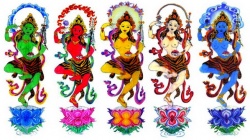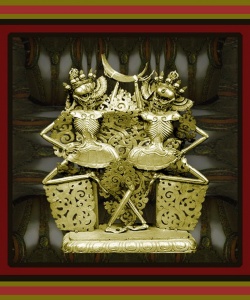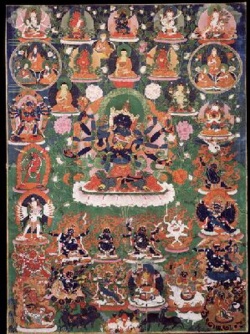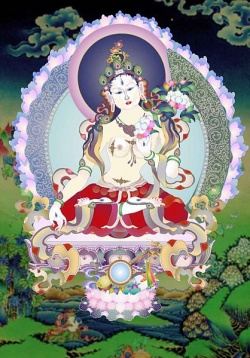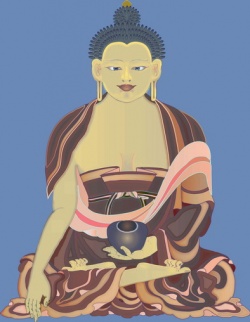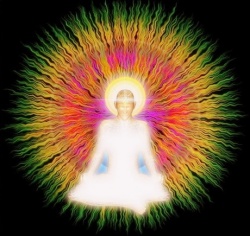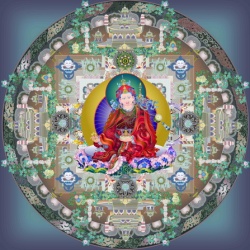Difference between revisions of "Theravadin religious women"
m (Text replacement - "boundaries" to "boundaries") |
|||
| Line 9: | Line 9: | ||
The legal position of a thila-shin in [[Burmese]] [[Buddhist law]] makes it clear that she is still a member of the {{Wiki|secular}} [[world]]; she is not deprived of {{Wiki|social}} rights to inherit estate and property, whereas [[monks]] and novices are governed by [[monastic rules]] that oblige them to {{Wiki|renounce}} all {{Wiki|secular}} rights. Nevertheless, in most cases a woman, should she become a [[thilashin]], voluntarily hands over her property to her family or donates her [[wealth]] to the [[nunnery]], considering it incompatible with the pursuit of a [[religious]] [[life]]; alternatively, she may use her inheritance to build her own accommodation inside the [[nunnery]] premises; after her [[death]], it becomes communal property of the institution. | The legal position of a thila-shin in [[Burmese]] [[Buddhist law]] makes it clear that she is still a member of the {{Wiki|secular}} [[world]]; she is not deprived of {{Wiki|social}} rights to inherit estate and property, whereas [[monks]] and novices are governed by [[monastic rules]] that oblige them to {{Wiki|renounce}} all {{Wiki|secular}} rights. Nevertheless, in most cases a woman, should she become a [[thilashin]], voluntarily hands over her property to her family or donates her [[wealth]] to the [[nunnery]], considering it incompatible with the pursuit of a [[religious]] [[life]]; alternatively, she may use her inheritance to build her own accommodation inside the [[nunnery]] premises; after her [[death]], it becomes communal property of the institution. | ||
| − | With regard to civil {{Wiki|status}}, a thila-shin is put in the same category as a [[monk]]. The {{Wiki|Constitution}} of [[Burma]] (No. 180, 1974) stipulates that gany [[religious]] personsh or gany member of the [[religious]] Orders,h whether [[Buddhist]], {{Wiki|Christian}}, {{Wiki|Muslim}}, etc., whether {{Wiki|male}} or {{Wiki|female}}, may not vote in elections. gReligious personsh are denied certain civil rights so that they do not engage in {{Wiki|political}} [[activities]]. This reflects {{Wiki|fear}} on the part of {{Wiki|political}} authorities in [[Burma]] that greligious personshmay exert their power in {{Wiki|secular}} [[forms]]. The assumption is that greligious personsh should be confined to the [[religious]] [[realm]], and in this [[respect]], both [[monks and nuns]] are considered to belong to the [[lokuttara]] (the [[realm]] of [[Buddhist]] [[attainment]] that transcends the | + | With regard to civil {{Wiki|status}}, a thila-shin is put in the same category as a [[monk]]. The {{Wiki|Constitution}} of [[Burma]] (No. 180, 1974) stipulates that gany [[religious]] personsh or gany member of the [[religious]] Orders,h whether [[Buddhist]], {{Wiki|Christian}}, {{Wiki|Muslim}}, etc., whether {{Wiki|male}} or {{Wiki|female}}, may not vote in elections. gReligious personsh are denied certain civil rights so that they do not engage in {{Wiki|political}} [[activities]]. This reflects {{Wiki|fear}} on the part of {{Wiki|political}} authorities in [[Burma]] that greligious personshmay exert their power in {{Wiki|secular}} [[forms]]. The assumption is that greligious personsh should be confined to the [[religious]] [[realm]], and in this [[respect]], both [[monks and nuns]] are considered to belong to the [[lokuttara]] (the [[realm]] of [[Buddhist]] [[attainment]] that transcends the boundaries of ordinary {{Wiki|social}} [[existence]]) rather than to the [[lokiya]] (the [[world]] of ordinary {{Wiki|social}} [[existence]]). |
In order to understand the {{Wiki|present}} [[standing]] of the thila-shin in [[Burma]], we have to understand the {{Wiki|distinction}} between [[lokiya]], [[worldly]] and [[mundane]], and [[lokuttara]], [[transcendental]] and [[spiritual]]. In [[Burma]], this {{Wiki|distinction}} is frequently referred to and understood as that between the {{Wiki|secular}} and the [[religious]]. Members of the [[Buddhist]] {{Wiki|community}} who have committed themselves to the ghigher idealh are referred to as those who belong to the [[lokuttara]], contrasted to those who belong to the [[lokiya]]. The [[lokuttara]] [[person]] is unproductive, and thus completely dependent on the {{Wiki|productive}} members of the [[lokiya]] for material support. The [[Buddhist]] {{Wiki|community}} provides a field of [[religious]] [[merit]] for {{Wiki|secular}} [[people]]. Accordingly, ggivingh is encouraged as the most [[meritorious]] and [[ethically]] valued [[activity]] for those in the [[lokiya]], while greceivingh is the norm of [[life]] for those in the [[lokuttara]]. The difference in ways of [[life]] is well [[recognized]] and the boundary between the two [[worlds]] is firmly maintained. They are dependent on one another, and this complementarity provides the basis for [[Burmese]] [[Buddhism]]. | In order to understand the {{Wiki|present}} [[standing]] of the thila-shin in [[Burma]], we have to understand the {{Wiki|distinction}} between [[lokiya]], [[worldly]] and [[mundane]], and [[lokuttara]], [[transcendental]] and [[spiritual]]. In [[Burma]], this {{Wiki|distinction}} is frequently referred to and understood as that between the {{Wiki|secular}} and the [[religious]]. Members of the [[Buddhist]] {{Wiki|community}} who have committed themselves to the ghigher idealh are referred to as those who belong to the [[lokuttara]], contrasted to those who belong to the [[lokiya]]. The [[lokuttara]] [[person]] is unproductive, and thus completely dependent on the {{Wiki|productive}} members of the [[lokiya]] for material support. The [[Buddhist]] {{Wiki|community}} provides a field of [[religious]] [[merit]] for {{Wiki|secular}} [[people]]. Accordingly, ggivingh is encouraged as the most [[meritorious]] and [[ethically]] valued [[activity]] for those in the [[lokiya]], while greceivingh is the norm of [[life]] for those in the [[lokuttara]]. The difference in ways of [[life]] is well [[recognized]] and the boundary between the two [[worlds]] is firmly maintained. They are dependent on one another, and this complementarity provides the basis for [[Burmese]] [[Buddhism]]. | ||
Revision as of 15:26, 31 December 2014
Hiroko Kawanami
The gofficial versionh of Buddhist texts in the Theravada tradition may serve as the starting point for understanding the religious status of contemporary Buddhist nuns. While doing my fieldwork, I found that stories of bhikkhunis and greligious womenh in the Buddhist texts were frequently referred to by monks and laity in an attempt to explain the present position of thila-shin in Burma. The formation of the Bhikkhuni Sangha and the textual account of bhikkhunis who once existed were important components of the story. Tradition also tells us that the lineage of bhikkhuni ordination has become extinct and there exists no bhikkhuni who can confer ordination on contemporary Buddhist nuns. Therefore, present-day thila-shin are not bhikkhunis. The pseudoordination ceremony that initiates laywomen into the Order is considered a ritual that provides them with a religious status no more than that of pious laywomen who abide by additional sabbatical vows. Ironically, the assumption that their predecessors once held a legitimate religious status seems to stress all the more the gillegitimateh religious status of present-day Buddhist nuns. These explanations are repeatedly referred to by monks and scholars to remind the general public of where a contemporary Buddhist nun gshould stand,h in order to perpetuate the ideology that gshe is not a bhikkhuni and that she can never become one.h According to traditional Buddhist classification, the Buddhist assembly comprised four kinds of people: bhikkhu (almsmen), bhikkhuni (almswomen), upasaka (devout laymen) and upasika (devout laywomen). Both male upasaka and female upasika were pious layfolk who followed the Buddhist morality of five precepts (eight on sabbatical days). These people were above all householders and material benefactors of the Sangha, called dayaka (donor) or dayika (female donor), and responsible for the upkeep of both the bhikkhu and bhikkhuni communities. The number of precepts taken is usually a major index of the religious status of an individual, and from this viewpoint, a thila-shin is categorized as an upasika (laywoman) who takes eight precepts. However, strictly speaking, a thila-shin does not fit into the category of upasika, because she is not a productive householder but an almswoman who is dependent on the laity.
Historically and socio-culturally, it seems that women have always been discouraged from spiritual renunciation. In the Hindu tradition, from which Buddhism arose, married status was the only acceptable way for women to pursue their religious goal. The institutionalized body of male renouncers was and still is dependent on lay householders for material support as well as for recruitment of celibate monks. Women were expected to look after the family and children, and be responsible for the perpetuation of the Buddhist faith to the future generation. Stories concerning pious laywomen were far more numerous and elaborated in the texts than those relating to Buddhist nuns. This implies that the role of female lay householders was far more acknowledged and encouraged than that of female renouncers in the Buddhist tradition. Present-day Buddhist nuns in Burma are called thila-shin. The Burmese term thila derives from the Pali word sila, which designates that virtuous behavior, ethical conduct, and moral practice which Buddhist texts list as the initial point of departure towards higher spirituality. The precepts Buddhists observe are also called thila. The Burmese word shin means the gholderh or gone who possesses.h Therefore, thila-shin means a person who observes the Buddhist code of morality, one who is virtuous and moral in every way this word would apply.
The legal position of a thila-shin in Burmese Buddhist law makes it clear that she is still a member of the secular world; she is not deprived of social rights to inherit estate and property, whereas monks and novices are governed by monastic rules that oblige them to renounce all secular rights. Nevertheless, in most cases a woman, should she become a thilashin, voluntarily hands over her property to her family or donates her wealth to the nunnery, considering it incompatible with the pursuit of a religious life; alternatively, she may use her inheritance to build her own accommodation inside the nunnery premises; after her death, it becomes communal property of the institution.
With regard to civil status, a thila-shin is put in the same category as a monk. The Constitution of Burma (No. 180, 1974) stipulates that gany religious personsh or gany member of the religious Orders,h whether Buddhist, Christian, Muslim, etc., whether male or female, may not vote in elections. gReligious personsh are denied certain civil rights so that they do not engage in political activities. This reflects fear on the part of political authorities in Burma that greligious personshmay exert their power in secular forms. The assumption is that greligious personsh should be confined to the religious realm, and in this respect, both monks and nuns are considered to belong to the lokuttara (the realm of Buddhist attainment that transcends the boundaries of ordinary social existence) rather than to the lokiya (the world of ordinary social existence).
In order to understand the present standing of the thila-shin in Burma, we have to understand the distinction between lokiya, worldly and mundane, and lokuttara, transcendental and spiritual. In Burma, this distinction is frequently referred to and understood as that between the secular and the religious. Members of the Buddhist community who have committed themselves to the ghigher idealh are referred to as those who belong to the lokuttara, contrasted to those who belong to the lokiya. The lokuttara person is unproductive, and thus completely dependent on the productive members of the lokiya for material support. The Buddhist community provides a field of religious merit for secular people. Accordingly, ggivingh is encouraged as the most meritorious and ethically valued activity for those in the lokiya, while greceivingh is the norm of life for those in the lokuttara. The difference in ways of life is well recognized and the boundary between the two worlds is firmly maintained. They are dependent on one another, and this complementarity provides the basis for Burmese Buddhism.
Thila-shin stand in between the lokiya and the lokuttara. Their position may be perceived as both lokiya and lokuttara, or part of either, depending on the situation and context, and according to the standing of the speaker in relationship to a thila-shin. Almost all my Burmese lay informants asserted that thila-shin did not belong to the lokiya. Having said that, some consider thila-shin as indispensable members of the lokuttara, vital to the maintenance of the Buddhist community, while some disregard them as a mere burden on the productive population. Monks, who officially adhere to the doctrine that contemporary nuns are glaywomen,h tend to discount their importance in everyday life. The thila-shin themselves strongly identify with the Buddhist community as far as their lifestyle and affiliation are concerned, yet their religious activities tend to centre around merit-making, entailing the act of ggivingh that is the focus of members of the lokiya.
A thila-shin seeks to clarify her standing by distinguishing her status from that of the permanent or semi-permanent yaw-gi (yogin in Pali) woman. Most Burmese laity, young and old, male and female, married and single, spend a certain time in meditation centres as yaw-gi. They are usually clad in brown, follow eight precepts, and meditate in religious premises. Most permanent or semi-permanent yaw-gi are old women relieved of their domestic chores and responsibilities. When asked why they had not become thila-shin, many of them said that they were too old to pursue a professional life. Furthermore, in contrast to a thila-shin, whose commitment to a religious cause is demonstrated by her shorn head, the retained hair of the yaw-gi was frequently derided as evidence of the lack of spiritual worth that made it difficult for them to detach themselves from the lokiya world.
Even though yaw-gi observe the same number of precepts and lead a stoic lifestyle in religious premises, they are regarded as basically outside the lokuttara. Still, thila-shin envy yaw-gi because they have more time for meditation and personal religious pursuits since, unlike nuns, yaw-gi are not expected to provide menial services for the monks or the Buddhist community. Also, yaw-gi cannot, nor do they wish to, live on greceivingh alms like the thila-shin. Therefore, in order to lead a religious life as yaw-gi, they have to be materially self-sufficient and fairly well-off, which suggests that they have not given up their role as gdonorsh who are responsible for ggivingh to the Buddhist community. At one level, the thila-shin claim that they have renounced the lay world to take up a life of stoic discipline and hardship. They say they have symbolically become gdaughters of the Buddhah and entered the Order of sisterhood for the pursuit of spiritual advancement. The keeping of Buddhist morality obliges them to abstain from sex, alcohol, eating after midday and from such worldly pleasures as singing and dancing and cosmetics and garlands, which may hinder their effort to purify the body and soul. Thila-shin say that their life is cool and clean compared to the hot and filthy life of the secular world. This gives them a reason to feel spiritually superior to the laity, both men and women. As mentioned before, the daily life of thila-shin is centered around merit-making activities that involvemenial services to the religious community of the monks. Perseverance and hardship are endured as ggivingh and sacrifices are believed to lead to the acquisition of merit. Many thilashin said that they were enabled to acquire more merit than those living in the secular world, since they could devote themselves wholeheartedly to a lifestyle with a religious cause, another reason for their spiritual superiority to the general laity.
However, there is a contradiction between the spiritual worthiness felt by thila-shin themselves and the mundane degradation to which they are subject. In order to cope with the embedded tension, they distinguish their relationship with the secular world on two levels: that of spiritual supremacy and that of economic dependence.
On an economic level, thila-shin seem to be reminded of their worldliness. They feel down-graded, inferior, and gbad,h being obliged to be economically dependent on their lay benefactors despite their gillegitimateh religious status. Thila-shin are aware that theoretically they are not full members of the Buddhist Order. Therefore, they feel that they are not fully entitled gto receiveh like the monks and novices whose legitimate religious status, backed by the Sangha, gives them full rights to receive from the laity. The alms received by monks and thila-shin appear to be fundamentally different. Thila-shin are given raw rice and money, which indicates that they can cook and look after themselves, in contrast to the monks, who are given only cooked food. The degree of autonomy maintained by the thila-shin shows that they retain a closer link to the secular than monks, who are completely dependent on the laity. In most big monasteries, there usually are lay helpers to offer the monks menial services, such as cooking and washing, so it is not necessary for the thila-shin to perform these duties. Nonetheless, thila-shin are eager to take part in merit-making activities by offering food to the monks. They like to gbe in need of the monksh and this becomes almost a religious objective for some of them. However, it must be added that not all thila-shin spend their time cooking for and serving the monks; those who are students and teachers of Buddhist scriptures and philosophy devote most of their time to the work of education. Therefore, there is a division of labour among the nuns, and the basic economic unit within a Burmese nunnery is usually comprised of a partnership between a nun who teaches and a nun who is in charge of the household. It is wrong to assume that most nuns are servants for the monks, and to my surprise, I met many educated thila-shin who were not even able to boil water!
In a Buddhist culture, ggivingh (dana) is encouraged, but receiving gifts may become problematic. Although it is theoretically unnecessary for thila-shin to reciprocate a material gift with a material countergift, they feel comfortable in ggiving,h but greceivingh makes them feel gindebted.h While monks and novices enjoy the privilege of receiving to the full on the supposition that they are providing the laity with a chance to acquire religious merit, the role of recipient for thila-shin constantly reminds them of their ambiguous religious standing, such that they are not fully exempted from the social rules of reciprocity. When they receive, thila-shin recite and give out religious blessings in return. They may chant for the donor the gpowerfulh Buddhist protection- formulas called paritta. These are believed to ward off evil spirits and confer upon the recipient prosperity, safety, luck, and happiness.
Thila-shin also show their utmost hospitality and kindness, and offer whatever humble food they have whenever a lay guest visits their nunnery. But these acts are not sufficient to convince them that they have paid back their debts in terms of the religious merit acquired by their lay benefactors. The feeling of having to receive all the time becomes a psychological burden, and seems to make them feel inferior. At times, they expressed this as a wish not to descend to the status of a mere beggar who receives alms with no religious significance. Officially, gBuddhist nunsh observe eight precepts. Novices observe ten precepts and monks abide by the 227 rules of the Vinaya. Five precepts are considered as fundamental to Buddhist morality, so devout lay Buddhists abide by at least five. On uposatha days (determined by the waxing and waning of the moon), days during the Vassa (a three-month period.a kind of Buddhist gLenth.that coincides with the rainy season in eastern India, Sri Lanka, and mainland Southeast Asia), and on other special days, such as the day of the week when they were born, Burmese people make special efforts to observe an additional three precepts and interrupt their ordinary lay life by taking religious disciplines. gCelibacyh and gno solid food after middayh are important and difficult additional abstinences on these occasions.
There are thila-shin who attempt to abide by ten precepts, the same number taken by novices. These precepts may be the same in content, but different in context and significance. This derives from the precepttakersf difference in status. A novice is gon the way to becoming a fully ordained member of the Sangha,h whereas further religious status for a thila-shin is closed. This difference becomes clearer when we examine the manner in which the basic Buddhist precepts are taken. Novices and thila-shin recite and take the first six precepts in the same manner. For novices, the seventh and the eighth precepts are separated and recited as two precepts: (7) abstinence from dancing, singing, music, and shows, and (8) abstention from garlands, perfumes, cosmetics,
and adornment. Thila-shin and laity take these precepts as two precepts merged into one, which makes one long precept, counted as the seventh. The ninth precept.abstention from sleeping on luxurious beds.is ninth for novices only; the same precept slides into the place of the eighth for thila-shin and laity. Therefore, it is recited as the ninth for the novice and the eighth for thila-shin and laity. Technically speaking, this means that there is no ninth precept for thila-shin and laity, and the artificial gap created between the eighth and the tenth precept marks the boundary between their religious status and that of a novice. If a thila-shin wished to abide by the ten precepts, the present custom is to fill in the gap of the ninth position by reciting the phrase which sends loving kindness (metta) to all sentient beings, especially to the spirits. This allows her to carry on to the taking of the tenth precept. However, this so-called gninth precepth is not a precept of abstinence, but rather a code of behaviour set up for instrumental reasons. It seems that the gap stands as a reminder that the religious status of thila-shin is that of upasika, and the manner in which the precepts are taken seems to confine them to the same level as the laity, or lokiya. In the meanwhile, a novice confronts no gap which hinders him from following further precepts and he is led to a higher religious status in the lokuttara. The tenth precept prohibits the taker from handling gold and silver, which means, in effect, money. This precept has a considerable religious significance for contemporary Buddhist nuns, while it is taken for granted by monks and novices. Most thila-shin in Burma receive and handle money, and are rarely in a position to abstain from it.
They live under the constant pressure of low income, since their daily life has to be maintained on humble donations of 1 to 5 kyats, while monks receive 50 to 100 kyats for attending a religious function. Threatened by the insecurity of their financial base, thila-shin cannot abstain from fussing over money, haggling at markets and living as thriftily as possible.this seems to result in a general image of nuns as greedy. On the other hand, thila-shin are often indispensable to the administration of monasteries on behalf of the monks, who are not allowed to handle money. Still, they do not consider this role of treasurer as an important base of power from which to demand further influence. The negative value attributed to their capacity gto be ableh to handle money makes them feel worldly and degraded, and it is regarded more or less as a shackle that keeps them away from spiritual advancement. Abstinence from handling money comes to be regarded as a special privilege for thila-shin. Not having to deal with it is aspired to as a gcoolh state of detachment from ghoth matters, an unobtainable state of bliss. As
1. Gon (guna in Pali) was translated by my informants as ggood qualityh or gvirtue, worth, prestige, honourh; it connotes for Burmese Buddhists a special quality inherited from previous incarnations.
one thila-shin expressed it, if only she were relieved from worries about money and maintenance, she would be able to concentrate fully on Buddhist studies and meditation. Such a state was considered to give her the physical and spiritual freedom to concentrate wholeheartedly on her basic spiritual pursuit.
Only a few thila-shin in Burma are able to follow all ten precepts. To become a ten-precept thila-shin, a woman has to have either a wealthy family background or a highly successful academic career, or both, so as to be able to attract numerous donors and benefactors who can give her a solid financial standing. It may sound paradoxical, but to be in a position of detachment, she must have sufficient resources and backing to be able to afford it. She must also have a reliable layperson or a nun serve as a kat-pi-ya to attend to her needs. A kat-pi-ya will act as secretary and treasurer and attend to the daily needs of the ten-precept thila-shin. If money is donated to the thila-shin, her kat-pi-ya will receive and deal with it on her behalf. The actual difficulty lies in the fact that thila-shin are rarely in a position to be looked after like monks, since they usually cannot attract sufficient respect or attention from the laity to require being attended on a full-time basis. On the contrary, thila-shin themselves often act as kat-pi-ya to monks, looking after their financial interests and, as we have seen, acting as manager and treasurer for the running of monasteries.
Thila-shin who have attained the ten-precept status are regarded as those who have attained a higher stage of detachment, endowed with spiritual peace. They do not necessarily have to commit themselves to a lifestyle of collecting alms and receiving donations, which reverses the power relationship between the thila-shin and her lay donors. In general, ten-precept thila-shin still maintain close relationships with their lay donors, but give a general impression that they are not desperately in need. Having a secure backing gives them a feeling of assurance so that they do not feel servile or inferior in any way to their lay benefactors. The inner tension felt between their spiritual worth and economic dependency gradually resolves as the former gains strength. Ten-precept thila-shin are well respected, regarded as higher on the spiritual ladder than ordinary eight-precept thila-shin, and perceived to have a special quality called gon.1 Moreover, their status of gnot having to receiveh gives them more importance, hence reasons for the laity to give; thus,
2. Editorsf note: The reference is to the dasa sil maniyo (ten-precept mother) movement that is discussed by Tessa J. Bartholomeusz inWomen under the Bo Tree (New York: Cambridge University Press, 1994).
they become the centre of worship among Buddhist nuns. However, the formal religious status of ten-precept thila-shin is still considered to be that of upasika, since they have not been through an gofficialh ordination ceremony. The only implication may be that they have succeeded in renouncing their role of service to the monks and novices, and achieved a certain state of religious autonomy within the Buddhist community.
As a current movement in Sri Lanka shows, nuns clad in yellow who are ten-precept observers aspire to a higher religious status than ordinary eight-precept nuns.2 They are attempting to secure a proper religious status between that of lay upasika and bhikkhuni. The aim of this movement is to raise their religious status into a different category through strict morality, meditation, and recitation of the dhamma, so that they can approximate the ideal of gsainthoodh (arahantship). Similarly, in Burma, thila-shin are eager to enhance their spirituality in spite of many obstacles. The taking of ten precepts is a valid religious statement which signifies that a thila-shin has overcome the guncomfortableh position of being materially dependent on the laity. Some thila-shin take the ten precepts in the evening, even though it has no practical effect, since they go to markets and attend religious functions in the mornings. Some thila-shin keep the ten precepts on uposatha days, on the day of week on which they were born, or during theVassa. A nun may save up her whole donation income for the rest of the year to be able to abide by the ten precepts during the three months of Vassa.
The abstinence enjoined on the ten-precept abider is often combined with one or two austere Buddhist practices called dhutanga, which also enhance onefs spiritual stature. Among the most common of the thirteen kinds of dhutanga are the taking of one meal a day and the mixing up of all the food and taking it directly from the bowl, with no second helpings. To these basic dhutanga, thila-shin may add vegetarianism, eating only beans, no sleep, and so on. The observation of these trials is by no means forced upon them, but a matter strictly of individual choice and decision. If a thila-shin is healthy and committed enough to take upon herself this kind of hardship, her efforts and sacrifice are met with respect by the laity. The thila-shin herself also believes that she is on the path to a higher spiritual level.
Officially, thila-shin are not obliged to abide by as many rules and
3. Verbally transmitted rules are primarily about the everyday behaviour of thila-shin. Sneezing, laughing, talking loudly, big gestures, yawning, abusive words, big strides in walking, noisiness, laziness and lack of respect towards elders, etc., are all frowned upon as improper behaviour.
4. Every thila-shin in Sagaing Buddhist community (a community in Upper Burma) is required to memorize the gRegulations for Thila-shinh written in 1914 by the influential abbot of Maha Ganda-yon monastery. The rules stipulate details from the acceptance of newcomers, and daily routine, duties, and obligations, up to minor details of everyday behaviour, such as going out for alms, and behaviour towards monks, senior nuns, and towards laymen. Respect, obedience, mindfulness, moderation, and good manners are emphasized. It is interesting to note that proper conduct towards a monk is stipulated in every possible situation, which shows the full apprehension of the danger of monks and nuns living side-by-side in a small community. Punishments following the violation of these rules are also specified in detail.
regulations as monks. However, in practice, their daily life is governed by far more rules and minor details than that of monks and novices. These include both verbally transmitted rules3 and written regulations.4 Moreover, it is often the case that thila-shin explicitly display their seriousness towards their religious profession and give the impression that their commitment is stronger than that of the monks. Thila-shin seem to know that their religious position depends on their outward image.on how they are perceived in society.so they try all means to keep up their religious stance in good manners, clean clothes and pious behaviour, etc. It can be argued that the insecurity of their religious position drives them to make far more efforts in observing rules and regulations. The only way of keeping their religious position intact is by constantly working on it and displaying their gsuper-devoutness,h so that their pious image becomes widely acknowledged by the laity. It is this recognition and the general approval of society that give thila-shin a secure place in the lokuttara.
The essay in this chapter was taken from Taiko Yamasaki, Shingon: Japanese Esoteric Buddhism (Boston: Shambhala, 1988), 182.90. Reprinted by arrangement with Shambhala Publications, Inc., 300 Massachusetts Ave., Boston, MA 02115. 1. Here and in similar contexts the word monks will refer to both monks and nuns. These are contexts in which the group in question is made up primarily, though not exclusively, of male practitioners.
